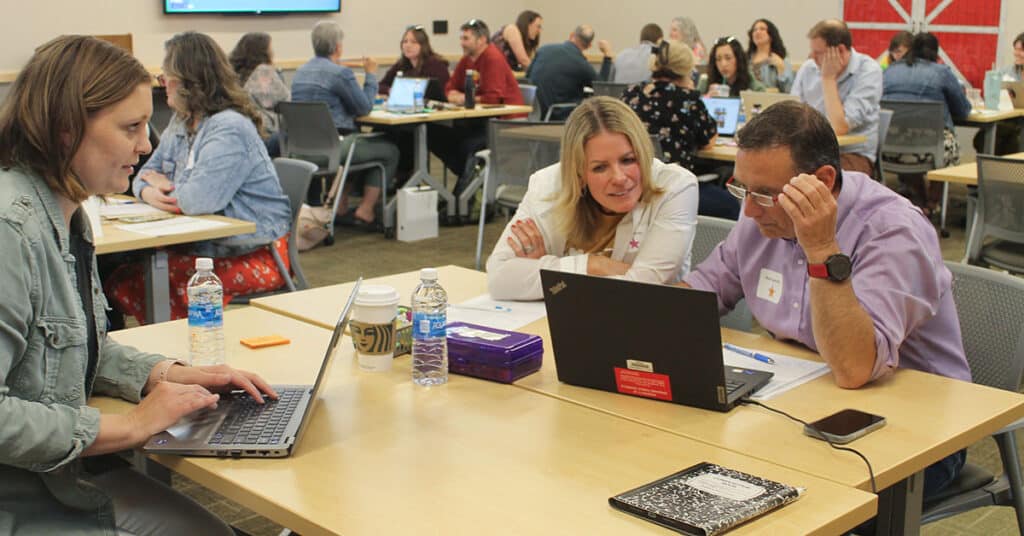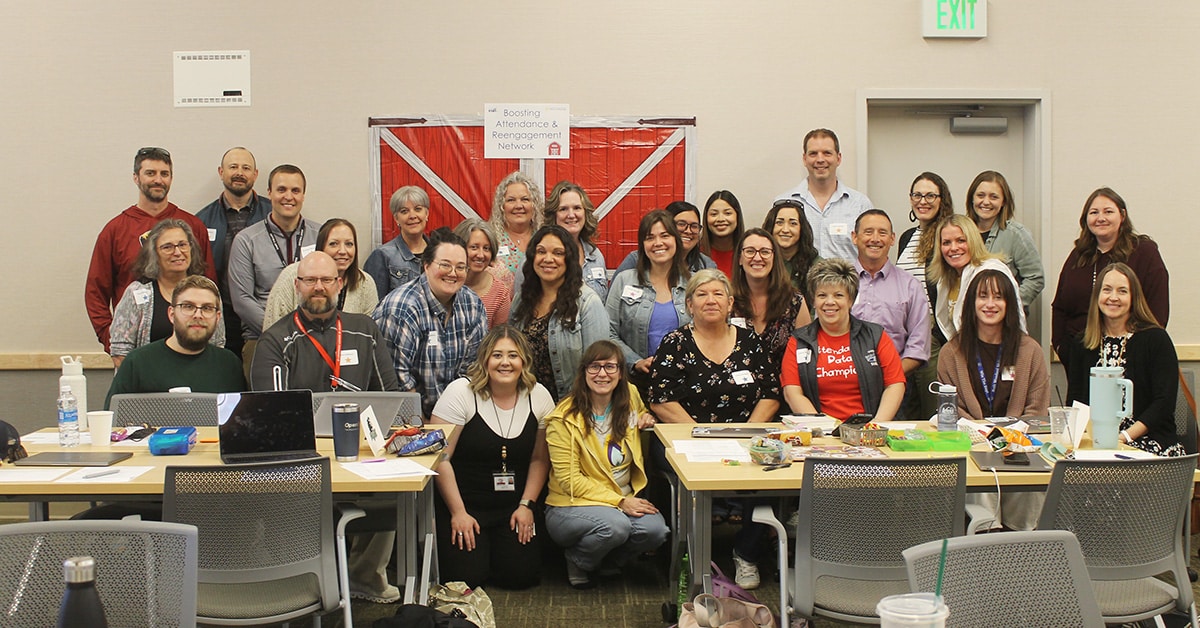


learn more about

learn more about

overview
partner with us
partner with us
events

events



learn more about

learn more about











What happens when you bring together two dozen schools—from rural K-12s to large urban high schools—with the shared goal of reducing chronic absenteeism? As three Attendance & Engagement Coordinators in Washington State, we found that doing so is a uniquely powerful way to ignite shared learning about what works, what doesn’t, and what to try next in reengaging students and families.
In partnership with the Office of Superintendent of Public Instruction, we launched and led attendance improvement networks across 24 diverse schools from June 2024 to June 2025. Our network aim was to decrease chronic absenteeism rates across these schools, with a focus on historically marginalized students. Despite their differences in context, every team wrestled with the same core challenge: how to reengage students and families in the wake of historic attendance declines.
Although future funding was unexpectedly cut due to a state budget shortfall, we are too invested to let what we’ve learned sit on a shelf. This article is for Washington’s education leaders, or anyone considering running an improvement network in education.
First, let’s backtrack to a fundamental question you may have: Why lead an improvement network focused on attendance?
Our answer: Because facilitating an improvement network proved far more powerful than working individually with schools one-on-one. The collaboration accelerated learning, sparked new ideas for change, and boosted morale across teams.
At first, some leaders questioned whether a network spanning such different grade levels and geographies would be useful. But at the very first convening, those doubts faded as school teams realized they were facing many of the same challenges. By year’s end, even the most hesitant leaders were saying things such as, “It made me feel like we’re not alone in this struggle.” That sense of solidarity and shared momentum turned out to be a powerful driver of progress.
If we had the chance to do it again, here are a few things we’d keep, and others we’d tweak.
A fundamental shift we witnessed was in mindset. Rather than focusing on bringing students and families into compliance, school teams began leading with empathy. “Instead of calling and kind of yelling or nagging,” said one principal, “it’s become a complete shift into calling and finding out what’s going on, why, and how we can help.” Tools like empathy interviews helped teams hear directly from students and families, revealing root causes of absenteeism and unlocking better strategies. Conducting an empathy interview requires listening without judgement in order to increase understanding of another person’s experience. For many of our school teams, conducting empathy interviews led to stronger relationships between staff and students and families, more honest communication, and solutions that effectively addressed barriers to attendance.
Next year: We’d encourage coaching teams to use empathy interviews not just once, but as an ongoing tool when they hit roadblocks or need clarity. Empathy interviews aren’t a box to check—they’re a habit of mind. For a deeper dive on conducting empathy interviews, see “What You Can Gain From Empathy Interviews And How to Avoid Common Traps”.
Hands down, participants said that learning from other school teams was the best part of the network experience. “Stealing ideas was the big one—and hearing what wouldn’t work for us was just as helpful,” explained one assistant principal. Presenting their work to peers within the network pushed school teams to reflect more deeply, and inspired others to do the same. Our initial hesitation to require presentations—because we didn’t want to add to the workload of overburdened staff—faded quickly as the benefits became obvious. Many of the teams who presented during the convenings later shared their learnings statewide in an Attendance Improvement Showcase. (Each school’s session was recorded and can be viewed on the OSPI’s Attendance Youtube Channel, such as College Place High School’s “Strong Teaming & Data” share.)
Next year: We’d make cross-team sharing a standing practice. Every team would share at least once, and we’d bring back the dilemma consultancy protocol—participants loved it and wanted more (we first experienced this protocol at High Tech High’s Meta Attendance Network and found it incredibly impactful; we used a version of the School Reform Initiative’s consultancy protocol).
Network teams consistently appreciated the practical and ready-to-use tools we created for them. Templates for agendas and data tracking helped teams stay focused and made the work easier to monitor and sustain. As one K-8 principal put it, “We got more done because we had something to follow… even when we lost a member midway, the other one was able to catch up because we had all that material in place.” We encouraged teams to be creative and flexible and make the tools their own, and some did adapt and add to what we gave them. But a surprising number took resources like the agenda template and used it as is—suggesting they valued having a ready-to-use tool specifically designed for their purpose.
Next year: We’d keep providing plug-and-play templates and encourage teams to find ways to refine them, creating space to improve useful materials and share them widely.
Like many other states, Washington uses a Multi-Tiered System of Supports (MTSS) framework to guide how schools build equity and close opportunity gaps among students. Interventions are organized into three tiers based on student need. Tier 1 includes universal supports that benefit all students, like engaging classroom practices, clear expectations, and positive school climate. Tier 2 involves targeted supports that adults deliver to students who need some additional help, while Tier 3 provides intensive, individualized interventions that are designed for students with the greatest needs.
Throughout the year, many teams came to a crucial realization: They were putting most of their energy into things like truancy conferences (Tier 3) and not enough time strengthening school wide practices that prevent absences in the first place (Tier 1). An elementary vice principal put it this way: “We figured out that tweaking a few Tier 1 things made a bigger difference than hunting down kids for truancy meetings.” Instead of constantly responding to attendance crises, school teams found that improving universal practices—like making morning routines more welcoming or adjusting how they communicated with families—prevented many problems before they started. This shift also helped teams realize they had more power than they thought, and more ways to take productive action without externalizing blame to families.
Next year: We’d continue encouraging teams to anchor their strategies in strong Tier 1 practices before building out Tier 2 and 3 supports. One activity that school teams took a lot from was reading and discussing the 2024 Ad Council Toolkit, How To Overcome Chronic Absenteeism and Encourage Parents To Send Kids To School Consistently.
Not everyone on a school team sees the problem—or solution—the same way. Some frame chronic absenteeism as a family issue, others as a matter of student engagement, and still others as a consequence of structural barriers. Unless team members articulate to each other their own theories about why something is or isn’t happening, it can be very difficult to move towards a shared goal. For example, if a staff member believes that students are missing school due to family issues, they probably won’t be on board with a solution intended to make students feel welcome (warm greetings at the door, for example) because they don’t think a lack of belonging is the source of the problem. Exploring everyone’s different theories is essential, and can be done productively when team members bring a mindset grounded in equity, curiosity, and a willingness to learn.

Next year: We’d add more tools and protocols to surface each person’s working theory about why students are missing school—and where they think change will happen. We’d then help teams connect those theories to the work they’re doing, so they can update their thinking as they learn throughout the year. This proved to be more difficult than we thought!
When schools treat improvement cycles like one-time fixes, they miss the point. Improvement is about iteration—planning, trying something new, learning from it, and trying again. Successful improvement teams commit to testing ideas, learning from results, and adjusting as they go. We wish we had emphasized earlier that teams were not here to solve things once and for all—they were here to test, learn, and test again. “You’re all scientists” would have set the right tone from day one.
Next year: We’d brand our convenings as “Attendance Labs” to reinforce the fact that the network is a place for experimentation and learning, not perfection.
One unexpected benefit of leading this network was how much we grew as facilitators—and how powerful it became when we shared that learning openly with each other. As regional coordinators, we benefited immensely from our weekly collaboration: sharing challenges, co-designing sessions, and supporting one another across convenings. This cross-pollination made our coaching stronger and more responsive. School teams in one region got to hear what was working in another, because we attended and supported each other’s convenings. Our work sessions across regions didn’t just make us better coaches; they modeled the very practices we were asking school teams to embrace: testing ideas, reflecting on what worked, and iterating based on feedback.
Next year: We’d be even more intentional about sharing our own “aha moments” during convenings—like realizing we needed to spend more time surfacing teams’ theories of change, or admitting when a protocol didn’t land as expected. Doing so would help normalize the true nature of improvement work. School teams would be able to see that even the “experts” were learning and adjusting, which would make it safer for them to take risks and share their own struggles. This sends a powerful message: that we’re all learners here, figuring it out together. When facilitators model curiosity and adaptation rather than expertise and certainty, it creates the psychological safety that real improvement work requires.
To those responsible for future planning and funding decisions, we’d encourage allocating time and resources for the kind of co-design and collaboration across regions that proved so critical for our own learning. It enriches the experience and strengthens outcomes for everyone involved.
Looking back, it wasn’t just our school teams that grew and improved—we did, too. Leading these attendance networks taught us that improvement work is fundamentally about relationships, learning, and iteration—not quick fixes or compliance measures. We also learned that when facilitators model the same curiosity and vulnerability we ask of schools, it creates the conditions for real, lasting change.
We hope the insights shared here will inspire anyone taking up this important work. Because improving attendance isn’t about fixing families or forcing compliance. It’s about building systems and cultures that make showing up feel possible—and worth it.
Ad Council. (2024). Back to the classroom: How to overcome chronic absenteeism and encourage parents to send kids to school consistently. https://www.adcouncil.org/learn-with-us/ad-council-research-institute/chronic-student-absenteeism
Dunne, F., Evans, P., & Thompson-Grove, G. (2020). Consultancy protocol: Framing consultancy dilemmas. U.S. Department of Education. https://www.ed.gov/sites/ed/files/2020/10/consultancy_structure_1.pdf
Fritz, A. (2025, September 5). What you can gain from empathy interviews: And how to avoid common traps. HTH Unboxed. https://hthgse.edu/what-you-can-gain-from-empathy-interviews/
waOSPI (2025, May 21). Strong teaming and data: College Place public schools attendance improvement showcase. [Video]. https://www.youtube.com/watch?v=jlwTOJsZYAs&list=PLh0gvWB_9LuWsIuW1-kCaYlUpQk8zhQ94&index=32
Washington State Office of Superintendent of Public Instruction. (2020). Washington’s multi-tiered system of supports framework. https://ospi.k12.wa.us/sites/default/files/2023-10/washington_s-mtss-framework-document.pdf
Washington State Office of Superintendent of Public Instruction. (2024). Tier 1 attendance team meeting roles and checklist template. https://ospi.k12.wa.us/sites/default/files/2024-12/tier_1_attendance_team_meeting_roles_and_checklist_template_0.docx